Hongye Su
A Rapid Iterative Trajectory Planning Method for Automated Parking through Differential Flatness
Aug 23, 2025Abstract:As autonomous driving continues to advance, automated parking is becoming increasingly essential. However, significant challenges arise when implementing path velocity decomposition (PVD) trajectory planning for automated parking. The primary challenge is ensuring rapid and precise collision-free trajectory planning, which is often in conflict. The secondary challenge involves maintaining sufficient control feasibility of the planned trajectory, particularly at gear shifting points (GSP). This paper proposes a PVD-based rapid iterative trajectory planning (RITP) method to solve the above challenges. The proposed method effectively balances the necessity for time efficiency and precise collision avoidance through a novel collision avoidance framework. Moreover, it enhances the overall control feasibility of the planned trajectory by incorporating the vehicle kinematics model and including terminal smoothing constraints (TSC) at GSP during path planning. Specifically, the proposed method leverages differential flatness to ensure the planned path adheres to the vehicle kinematic model. Additionally, it utilizes TSC to maintain curvature continuity at GSP, thereby enhancing the control feasibility of the overall trajectory. The simulation results demonstrate superior time efficiency and tracking errors compared to model-integrated and other iteration-based trajectory planning methods. In the real-world experiment, the proposed method was implemented and validated on a ROS-based vehicle, demonstrating the applicability of the RITP method for real vehicles.
* Published in the journal Robotics and Autonomous Systems
Multi-Mode Process Control Using Multi-Task Inverse Reinforcement Learning
May 27, 2025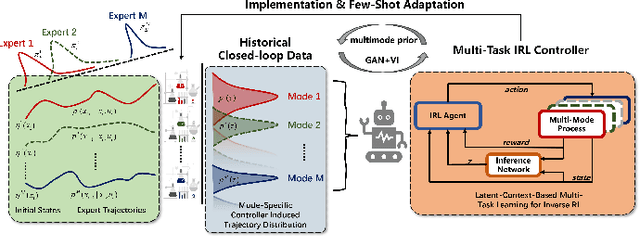
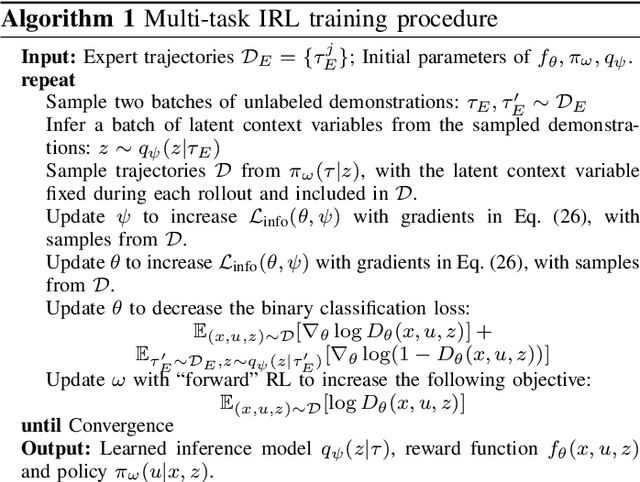
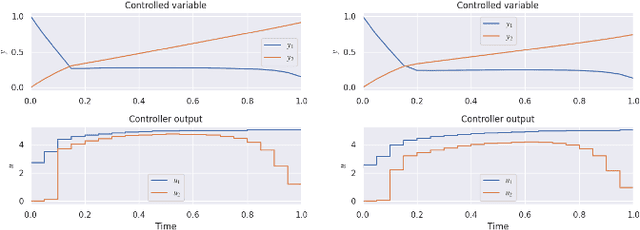
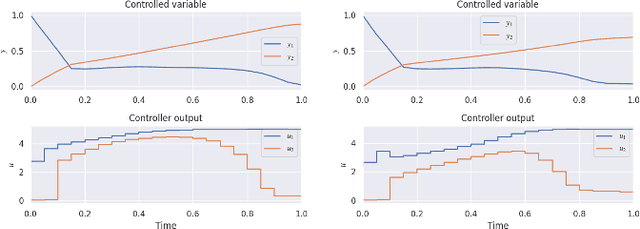
Abstract:In the era of Industry 4.0 and smart manufacturing, process systems engineering must adapt to digital transformation. While reinforcement learning offers a model-free approach to process control, its applications are limited by the dependence on accurate digital twins and well-designed reward functions. To address these limitations, this paper introduces a novel framework that integrates inverse reinforcement learning (IRL) with multi-task learning for data-driven, multi-mode control design. Using historical closed-loop data as expert demonstrations, IRL extracts optimal reward functions and control policies. A latent-context variable is incorporated to distinguish modes, enabling the training of mode-specific controllers. Case studies on a continuous stirred tank reactor and a fed-batch bioreactor validate the effectiveness of this framework in handling multi-mode data and training adaptable controllers.
Adaptive Learning-based Model Predictive Control Strategy for Drift Vehicles
Feb 07, 2025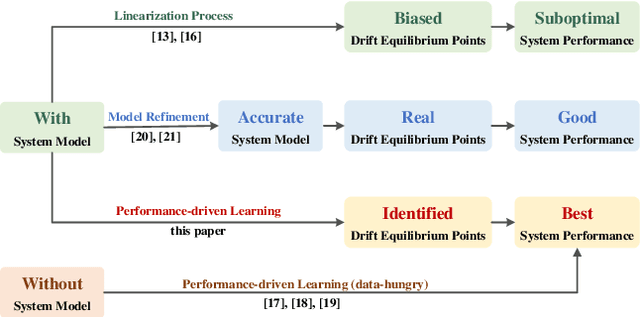
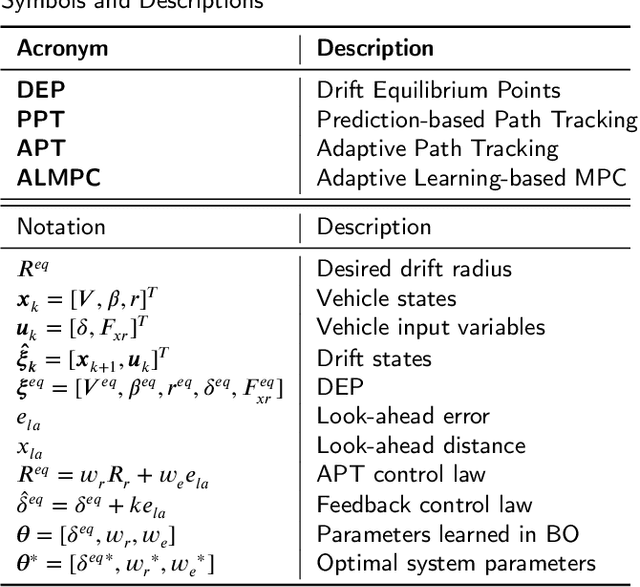
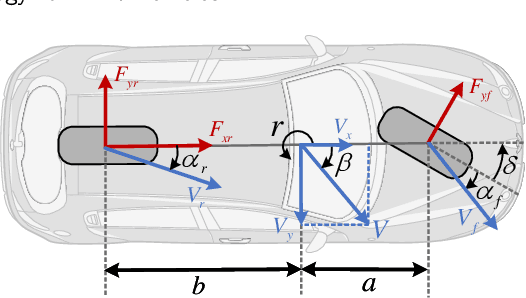
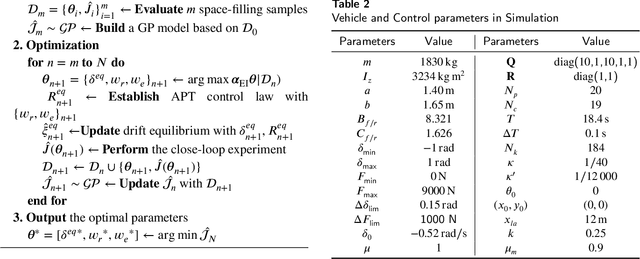
Abstract:Drift vehicle control offers valuable insights to support safe autonomous driving in extreme conditions, which hinges on tracking a particular path while maintaining the vehicle states near the drift equilibrium points (DEP). However, conventional tracking methods are not adaptable for drift vehicles due to their opposite steering angle and yaw rate. In this paper, we propose an adaptive path tracking (APT) control method to dynamically adjust drift states to follow the reference path, improving the commonly utilized predictive path tracking methods with released computation burden. Furthermore, existing control strategies necessitate a precise system model to calculate the DEP, which can be more intractable due to the highly nonlinear drift dynamics and sensitive vehicle parameters. To tackle this problem, an adaptive learning-based model predictive control (ALMPC) strategy is proposed based on the APT method, where an upper-level Bayesian optimization is employed to learn the DEP and APT control law to instruct a lower-level MPC drift controller. This hierarchical system architecture can also resolve the inherent control conflict between path tracking and drifting by separating these objectives into different layers. The ALMPC strategy is verified on the Matlab-Carsim platform, and simulation results demonstrate its effectiveness in controlling the drift vehicle to follow a clothoid-based reference path even with the misidentified road friction parameter.
Reduce Lap Time for Autonomous Racing with Curvature-Integrated MPCC Local Trajectory Planning Method
Feb 06, 2025



Abstract:The widespread application of autonomous driving technology has significantly advanced the field of autonomous racing. Model Predictive Contouring Control (MPCC) is a highly effective local trajectory planning method for autonomous racing. However, the traditional MPCC method struggles with racetracks that have significant curvature changes, limiting the performance of the vehicle during autonomous racing. To address this issue, we propose a curvature-integrated MPCC (CiMPCC) local trajectory planning method for autonomous racing. This method optimizes the velocity of the local trajectory based on the curvature of the racetrack centerline. The specific implementation involves mapping the curvature of the racetrack centerline to a reference velocity profile, which is then incorporated into the cost function for optimizing the velocity of the local trajectory. This reference velocity profile is created by normalizing and mapping the curvature of the racetrack centerline, thereby ensuring efficient and performance-oriented local trajectory planning in racetracks with significant curvature. The proposed CiMPCC method has been experimented on a self-built 1:10 scale F1TENTH racing vehicle deployed with ROS platform. The experimental results demonstrate that the proposed method achieves outstanding results on a challenging racetrack with sharp curvature, improving the overall lap time by 11.4%-12.5% compared to other autonomous racing trajectory planning methods. Our code is available at https://github.com/zhouhengli/CiMPCC.
Three-Dimensional Sparse Random Mode Decomposition for Mode Disentangling with Crossover Instantaneous Frequencies
Jan 25, 2025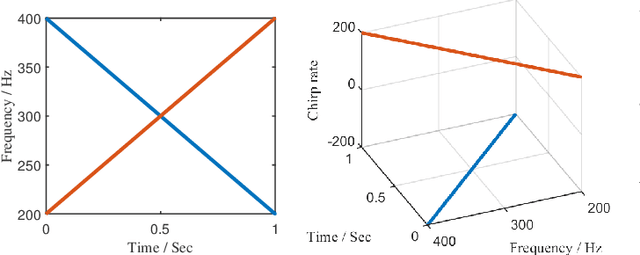
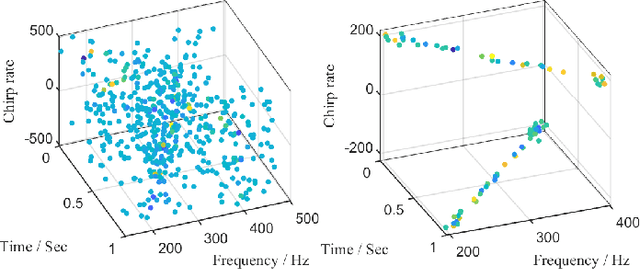
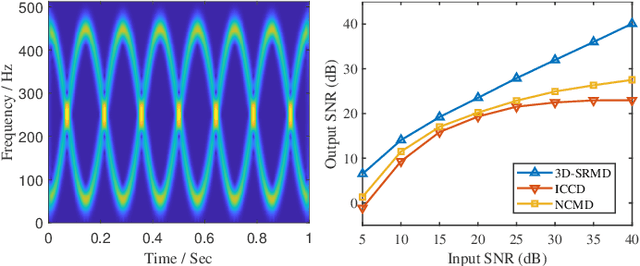
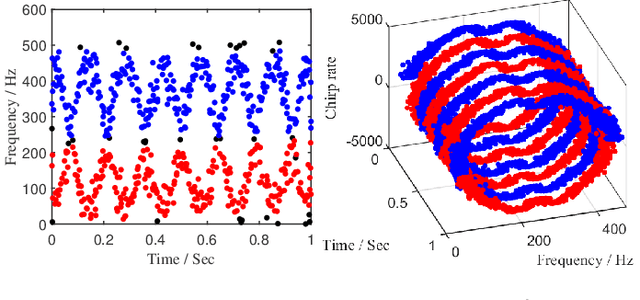
Abstract:Sparse random mode decomposition (SRMD) is a novel algorithm that constructs a random time-frequency feature space to sparsely approximate spectrograms, effectively separating modes. However, it fails to distinguish adjacent or overlapped frequency components, especially, those with crossover instantaneous frequencies. To address this limitation, an enhanced version, termed three-dimensional SRMD (3D-SRMD), is proposed in this letter. In 3D-SRMD, the random features are lifted from a two-dimensional space to a three-dimensional (3D) space by introducing one extra chirp rate axis. This enhancement effectively disentangles the frequency components overlapped in the low dimension. Additionally, a novel random feature generation strategy is designed to improve the separation accuracy of 3D-SRMD by combining the 3D ridge detection method. Finally, numerical experiments on both simulated and real-world signals demonstrate the effectiveness of our method.
An Overtaking Trajectory Planning Framework Based on Spatio-temporal Topology and Reachable Set Analysis Ensuring Time Efficiency
Oct 30, 2024



Abstract:Generating overtaking trajectories in high-speed scenarios presents significant challenges and is typically addressed through hierarchical planning methods. However, this method has two primary drawbacks. First, heuristic algorithms can only provide a single initial solution, which may lead to local optima and consequently diminish the quality of the solution. Second, the time efficiency of trajectory refinement based on numerical optimization is insufficient. To overcome these limitations, this paper proposes an overtaking trajectory planning framework based on spatio-temporal topology and reachable set analysis (SROP), to improve trajectory quality and time efficiency. Specifically, this paper introduces topological classes to describe trajectories representing different overtaking behaviors, which support the spatio-temporal topological search method employed by the upper-layer planner to identify diverse initial paths. This approach helps prevent getting stuck in local optima, enhancing the overall solution quality by considering multiple initial solutions from distinct topologies. Moreover, the reachable set method is integrated into the lower-layer planner for parallel trajectory evaluation. This method enhances planning efficiency by decoupling vehicle model constraints from the optimization process, enabling parallel computation while ensuring control feasibility. Simulation results show that the proposed method improves the smoothness of generated trajectories by 66.8% compared to state-of-the-art methods, highlighting its effectiveness in enhancing trajectory quality. Additionally, this method reduces computation time by 62.9%, demonstrating its efficiency.
A Data-Driven Aggressive Autonomous Racing Framework Utilizing Local Trajectory Planning with Velocity Prediction
Oct 15, 2024Abstract:The development of autonomous driving has boosted the research on autonomous racing. However, existing local trajectory planning methods have difficulty planning trajectories with optimal velocity profiles at racetracks with sharp corners, thus weakening the performance of autonomous racing. To address this problem, we propose a local trajectory planning method that integrates Velocity Prediction based on Model Predictive Contour Control (VPMPCC). The optimal parameters of VPMPCC are learned through Bayesian Optimization (BO) based on a proposed novel Objective Function adapted to Racing (OFR). Specifically, VPMPCC achieves velocity prediction by encoding the racetrack as a reference velocity profile and incorporating it into the optimization problem. This method optimizes the velocity profile of local trajectories, especially at corners with significant curvature. The proposed OFR balances racing performance with vehicle safety, ensuring safe and efficient BO training. In the simulation, the number of training iterations for OFR-based BO is reduced by 42.86% compared to the state-of-the-art method. The optimal simulation-trained parameters are then applied to a real-world F1TENTH vehicle without retraining. During prolonged racing on a custom-built racetrack featuring significant sharp corners, the mean velocity of VPMPCC reaches 93.18% of the vehicle's handling limits. The released code is available at https://github.com/zhouhengli/VPMPCC.
Learning to Race in Extreme Turning Scene with Active Exploration and Gaussian Process Regression-based MPC
Oct 08, 2024
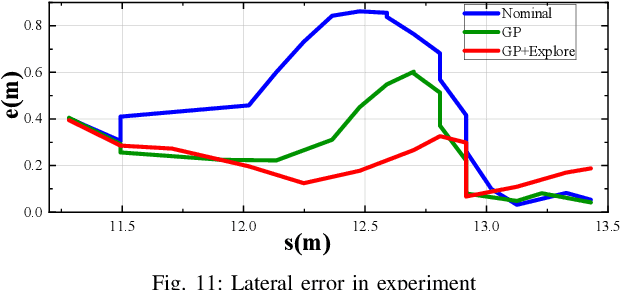
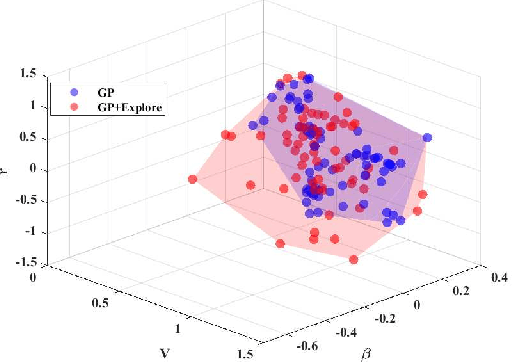
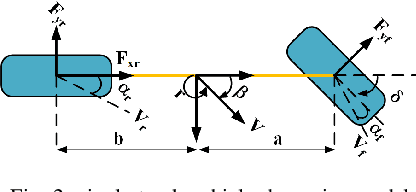
Abstract:Extreme cornering in racing often induces large side-slip angles, presenting a formidable challenge in vehicle control. To tackle this issue, this paper introduces an Active Exploration with Double GPR (AEDGPR) system. The system initiates by planning a minimum-time trajectory with a Gaussian Process Regression(GPR) compensated model. The planning results show that in the cornering section, the yaw angular velocity and side-slip angle are in opposite directions, indicating that the vehicle is drifting. In response, we develop a drift controller based on Model Predictive Control (MPC) and incorporate Gaussian Process Regression to correct discrepancies in the vehicle dynamics model. Moreover, the covariance from the GPR is employed to actively explore various cornering states, aiming to minimize trajectory tracking errors. The proposed algorithm is validated through simulations on the Simulink-Carsim platform and experiments using a 1/10 scale RC vehicle.
Nonlinear sparse variational Bayesian learning based model predictive control with application to PEMFC temperature control
Apr 15, 2024Abstract:The accuracy of the underlying model predictions is crucial for the success of model predictive control (MPC) applications. If the model is unable to accurately analyze the dynamics of the controlled system, the performance and stability guarantees provided by MPC may not be achieved. Learning-based MPC can learn models from data, improving the applicability and reliability of MPC. This study develops a nonlinear sparse variational Bayesian learning based MPC (NSVB-MPC) for nonlinear systems, where the model is learned by the developed NSVB method. Variational inference is used by NSVB-MPC to assess the predictive accuracy and make the necessary corrections to quantify system uncertainty. The suggested approach ensures input-to-state (ISS) and the feasibility of recursive constraints in accordance with the concept of an invariant terminal region. Finally, a PEMFC temperature control model experiment confirms the effectiveness of the NSVB-MPC method.
Dynamic fault detection and diagnosis of industrial alkaline water electrolyzer process with variational Bayesian dictionary learning
Apr 15, 2024


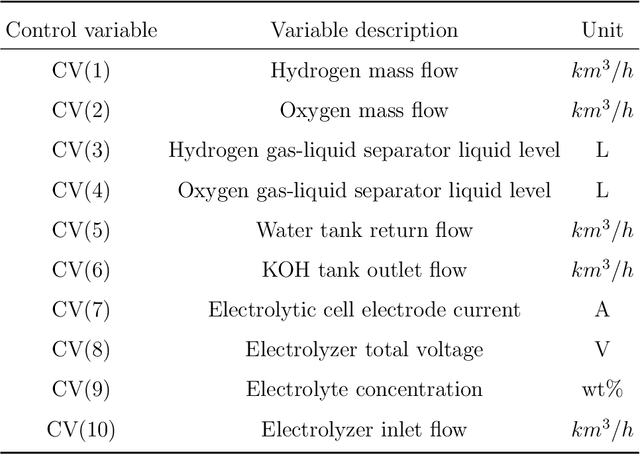
Abstract:Alkaline Water Electrolysis (AWE) is one of the simplest green hydrogen production method using renewable energy. AWE system typically yields process variables that are serially correlated and contaminated by measurement uncertainty. A novel robust dynamic variational Bayesian dictionary learning (RDVDL) monitoring approach is proposed to improve the reliability and safety of AWE operation. RDVDL employs a sparse Bayesian dictionary learning to preserve the dynamic mechanism information of AWE process which allows the easy interpretation of fault detection results. To improve the robustness to measurement uncertainty, a low-rank vector autoregressive (VAR) method is derived to reliably extract the serial correlation from process variables. The effectiveness of the proposed approach is demonstrated with an industrial hydrogen production process, and RDVDL can efficiently detect and diagnose critical AWE faults.
 Add to Chrome
Add to Chrome Add to Firefox
Add to Firefox Add to Edge
Add to Edge